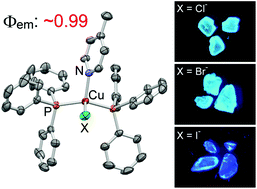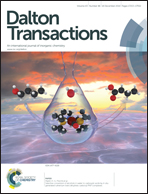Simple and extremely efficient blue emitters based on mononuclear Cu(i)-halide complexes with delayed fluorescence†
Abstract
Simple mononuclear Cu(I)-halide complexes, [CuX(PPh3)2(4-Mepy)] (X = Cl−, Br−, I−; PPh3 = triphenylphosphine; 4-Mepy = 4-methylpyridine), were prepared. They exhibit blue light emission, with extremely high photoluminescence quantum yields approaching 100% in the crystals. Emission lifetime analyses and density functional theory calculations revealed that the bright blue light emission at room temperature is mainly delayed fluorescence originating from the singlet metal-to-ligand charge transfer (MLCT) state combined with the halide-to-ligand charge transfer (XLCT) state, (1(M + X)LCT), while that at 77 K is phosphorescence from the 3(M + X)LCT transition state, due to the small singlet–triplet energy differences (ΔE = 940–1170 cm−1). The ternary ligand systems consisting of halide, bulky phosphine, and N-heteroaromatic ligands constitute inexpensive pure-blue-light-emitting materials, which can be fabricated by facile procedures such as simple manual grinding.


 Please wait while we load your content...
Please wait while we load your content...